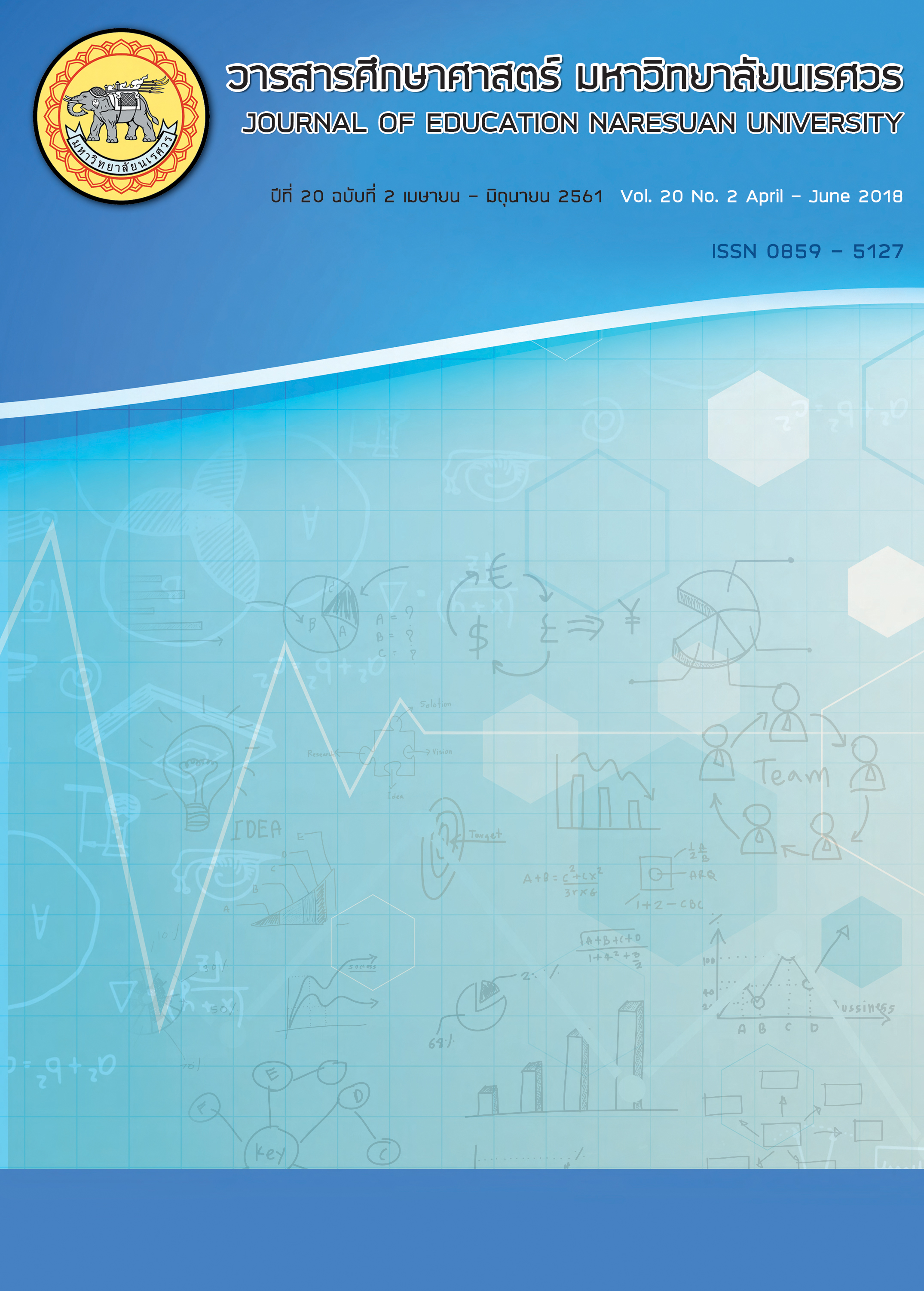ความท้าทายในการประยุกต์ใช้เทคโนโลยีความเป็นจริงเสริมกับการศึกษายุค 4.0; CHALLENGES ON AUGMENTED REALITY FOR EDUCATION 4.0
Main Article Content
Abstract
การศึกษายุค 4.0 เป็นการเรียนการสอนที่เน้นให้ผู้เรียนได้ศึกษาหาความรู้ด้วยตนเองโดยสามารถศึกษาได้จากแหล่งข้อมูลหรือการเรียนรู้ในทุกรูปแบบ รวมทั้งสามารถพัฒนาและสร้างนวัตกรรมได้ ซึ่งในปัจจุบันนั้นมีสื่อการเรียนรู้มากมายหลายแบบ สื่อเทคโนโลยีความเป็นจริงเสริม (Augmented Reality) เป็นเทคโนโลยี ซึ่งผสมผสานระหว่างโลกแห่งความเป็นจริงเข้ากับโลกเสมือน โดยการใช้เทคนิคการซ้อนภาพสามมิติที่สร้างขึ้นให้ไปแสดงผลและสามารถโต้ตอบกับผู้ใช้ได้ทันที ผ่านซอฟต์แวร์และอุปกรณ์เชื่อมต่อที่มีกล้อง เช่น เว็บแคม โทรศัพท์หรือสมาร์ทโฟน และแท็บเล็ต โดยสื่อการเรียนรู้ที่พัฒนามาจากเทคโนโลยีความเป็นจริงเสริมเป็นเทคโนโลยีใหม่ที่สามารถนำมาใช้เพื่อกระตุ้นให้ผู้เรียนอยากรู้อยากเห็นและเรียนรู้สิ่งใหม่ สร้างประสบการณ์ที่แปลกใหม่ ได้เรียนรู้ในสิ่งที่ตนเองอยากเรียนแล้วนำความรู้ที่ได้มาพัฒนาและสร้างนวัตกรรมที่เป็นประโยชน์ให้กับสังคม ซึ่งทำให้การเรียนรู้มีความท้าทายและน่าสนใจ ปัจจุบันได้เริ่มมีการพัฒนาการประยุกต์ใช้เทคโนโลยีความเป็นจริงเสริมในด้านการศึกษาเพิ่มมากขึ้น บทความนี้ครอบคลุมแนวคิดและหลักการทำงานของเทคโนโลยีความเป็นจริงเสริม การศึกษายุค 4.0 แนวทางการพัฒนาเทคโนโลยีความเป็นจริงเสริมกับการนำมาใช้ในการศึกษายุค 4.0
CHALLENGES ON AUGMENTED REALITY FOR EDUCATION 4.0
Education 4.0 is to encourage independent learning for students involved with ability to acquire information through sources or other learning media as well as the ability to develop and build innovation skills. Nowadays, there are many learning media, and Augmented Reality is a technology enriching the real world with digital information by using Anaglyphic 3D image connected via software and devices such as camera, webcam, smartphone or tablet. Augmented Reality is a new technology which has a positive impact on the motivation of students and provide a framework for students to engage with new learning and incredible experience. Students will be able to apply their knowledge to develop and build innovation lead to prosperity for societies. At present, Augmented Reality is increasingly used for education. This study is to provide a comprehensive concept, method of development, element and process of Augmented Reality for Education 4.0.
Article Details
The owner of the article does not copy or violate any of its copyright. If any copyright infringement occurs or prosecution, in any case, the Editorial Board is not involved in all the rights to the owner of the article to be performed.
References
Bojukrapan, S., et al. (2016). The development of the instructional media with augmented reality technology entitled atomic model for Matthayomsuksa 4 students. In the 2nd National Conference on Technology and Innovation Management NCTIM 2016 (pp. 151-157). Maha Sarakham: Rajabhat Maha Sarakham University. (in Thai)
Chen Ching Hui, et al. (2015). The development of an augmented reality game-based learning environment. Procedia - Social and Behavioral Sciences, 174, 216 – 220.
Danakorn Nincarean Eh Phon, & Mohamad Bilal Ali. (2014). Collaborative augmented reality in education: A review. Teaching and Learning in Computing and Engineering (LaTiCE), DOI: 10.1109/LaTiCE.2014.23.
Ditcharoen, N., Polyiam, K., Vangkahad, P., & Jarujamrus, P. (2015). Development of learning media in topics of atomic structure and chemical bond with augmented reality technology. Journal of Research Unit on Science, Technology and Environment for Learning, 5(1), 21-27. (in Thai)
Iwakura, Y., Mouri, C., Tenzou, H., Manabe, S., & Johnston, R. (2015). An educational AR system for visualizing radiation interactions with human tissue. IEEE Nuclear Science Symposium and Medical Imaging Conference (NSS/MIC), 1-4.
Josh. (2014). Augmented reality is the real game changer in education. Retrieve May 7, 2016, from https://professorjosh.com/2014/04/10/augmentative-reality-is-the-real-game-changer-ineducation
Kalarat, K. (2015). Applying relief mapping on augmented reality. In 2015 12th International Joint Conference on Computer Science and Software Engineering (JCSSE), pp. 315 – 318. (in Thai)
Kollektive Wahrnehmung. (2010). Augmented Reality Periodic Table | First test shots. Retrieve May 7, 2016, from https://vimeo.com/11636618
Lee, K. W. (2000). English teachers' barriers to the use of computer-assisted language learning [Electronic Version]. The Internet TESL Journal VI, from https://iteslj.org/Articles/Lee-CALLbarriers.html
Meesuwan, W. (2011). Augmented reality technology for learning. Journal of Education Naresuan University, 13(12), 119-127. (in Thai)
Mhd Wael Bazzaza, Buti Al Delail, M. Jamal Zemerly, & Jason W.P. Ng. (2014). iARBook: An immersive augmented reality system for education. Teaching, Assessment and Learning (TALE), 2014. International Conference (pp.495-498).
Poovarawan, Y. (2014). New frontier of learning: education 4.0. learning innovation center. Bangkok: Chulalongkorn University. (in Thai)
Sinlarat, P. (2016). Education 4.0. Retrieve March 10, 2017, from https://goo.gl/Kt5SAN (in Thai)
Tansiri, P. (2010). Augmented Reality. Executive Journal, 30(2), 169-175. (in Thai)
Vongsripeng, S., & Utakrit, N. (2012). Applies augmented reality techniques to use to teach Thai alphabet. The Eighth National Conference on Computing and Information Technology. Bangkok: King Mongkut's University of Technology North Bangkok. (in Thai)


